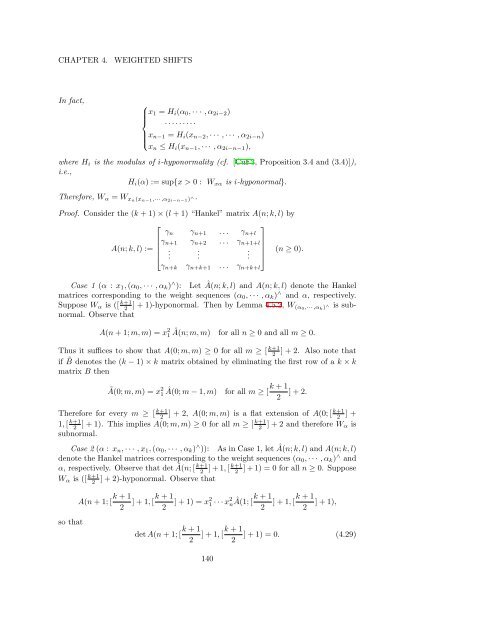Woo Young Lee Lecture Notes on Operator Theory
Woo Young Lee Lecture Notes on Operator Theory
Woo Young Lee Lecture Notes on Operator Theory
Create successful ePaper yourself
Turn your PDF publications into a flip-book with our unique Google optimized e-Paper software.
CHAPTER 4.<br />
WEIGHTED SHIFTS<br />
In fact,<br />
⎧<br />
x 1 = H i (α 0 , · · · , α 2i−2 )<br />
⎪⎨<br />
· · · · · · · · ·<br />
x n−1 = H i (x n−2 , · · · , · · · , α 2i−n )<br />
⎪⎩<br />
x n ≤ H i (x n−1 , · · · , α 2i−n−1 ),<br />
where H i is the modulus of i-hyp<strong>on</strong>ormality (cf. [CuF3, Propositi<strong>on</strong> 3.4 and (3.4)]),<br />
i.e.,<br />
H i (α) := sup{x > 0 : W xα is i-hyp<strong>on</strong>ormal}.<br />
Therefore, W α = W xn (x n−1 ,··· ,α 2i−n−1 ) ∧.<br />
Proof. C<strong>on</strong>sider the (k + 1) × (l + 1) “Hankel” matrix A(n; k, l) by<br />
⎡<br />
⎤<br />
γ n γ n+1 . . . γ n+l<br />
γ n+1 γ n+2 . . . γ n+1+l<br />
A(n; k, l) := ⎢<br />
⎥<br />
⎣ . .<br />
. ⎦<br />
γ n+k γ n+k+1 . . . γ n+k+l<br />
(n ≥ 0).<br />
Case 1 (α : x 1 , (α 0 , · · · , α k ) ∧ ): Let Â(n; k, l) and A(n; k, l) denote the Hankel<br />
matrices corresp<strong>on</strong>ding to the weight sequences (α 0 , · · · , α k ) ∧ and α, respectively.<br />
Suppose W α is ([ k+1<br />
2 ] + 1)-hyp<strong>on</strong>ormal. Then by Lemma 4.5.2, W (α 0,··· ,α k ) ∧ is subnormal.<br />
Observe that<br />
A(n + 1; m, m) = x 2 1 Â(n; m, m) for all n ≥ 0 and all m ≥ 0.<br />
Thus it suffices to show that A(0; m, m) ≥ 0 for all m ≥ [ k+1<br />
2<br />
] + 2. Also note that<br />
if ˜B denotes the (k − 1) × k matrix obtained by eliminating the first row of a k × k<br />
matrix B then<br />
Ã(0; m, m) = x 2 1<br />
+ 1<br />
Â(0; m − 1, m) for all m ≥ [k ] + 2.<br />
2<br />
Therefore for every m ≥ [ k+1<br />
k+1<br />
2<br />
] + 2, A(0; m, m) is a flat extensi<strong>on</strong> of A(0; [<br />
2 ] +<br />
1, [ k+1<br />
k+1<br />
2<br />
] + 1). This implies A(0; m, m) ≥ 0 for all m ≥ [<br />
2 ] + 2 and therefore W α is<br />
subnormal.<br />
Case 2 (α : x n , · · · , x 1 , (α 0 , · · · , α k ) ∧ )): As in Case 1, let Â(n; k, l) and A(n; k, l)<br />
denote the Hankel matrices corresp<strong>on</strong>ding to the weight sequences (α 0 , · · · , α k ) ∧ and<br />
k+1 k+1<br />
α, respectively. Observe that det Â(n; [<br />
2<br />
] + 1, [<br />
2<br />
] + 1) = 0 for all n ≥ 0. Suppose<br />
W α is ([ k+1<br />
2<br />
] + 2)-hyp<strong>on</strong>ormal. Observe that<br />
so that<br />
A(n + 1; [ k + 1<br />
2<br />
] + 1, [ k + 1 ] + 1) = x 2 1 · · · x<br />
2<br />
det A(n + 1; [ k + 1<br />
2<br />
2 + 1<br />
nÂ(1; [k<br />
2<br />
] + 1, [ k + 1 ] + 1),<br />
2<br />
] + 1, [ k + 1 ] + 1) = 0. (4.29)<br />
2<br />
140













